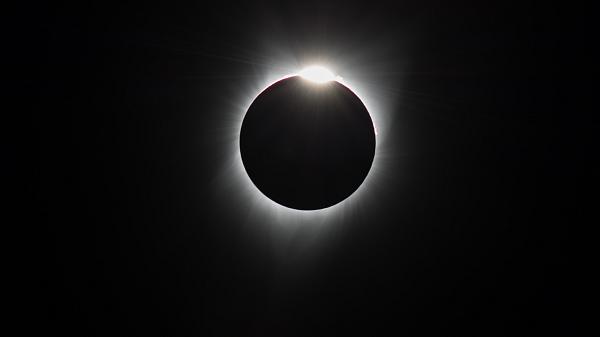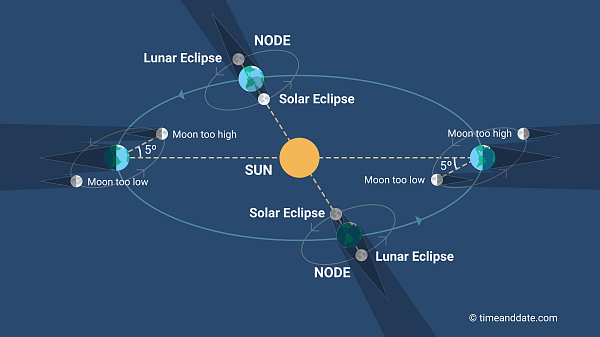When Will We See a Solar Eclipse When Will We See a Lunar Eclipse Again

Spot the diamond band!
©iStockphoto.com/drial7m1
How Many Eclipses in a Yr?
Most calendar years have two solar eclipses. The maximum number of solar eclipses that can have identify in the same year is five, just this is rare. Co-ordinate to NASA calculations, only about 25 years in the past five,000 years accept had five solar eclipses. The last fourth dimension this happened was in 1935, and the next time volition be in 2206.
List Solar Eclipses 1900–2199
Types of Solar Eclipses
In that location are three main types of solar eclipses:
- total solar eclipses
- annular eclipses
- partial solar eclipses
In addition, at that place are hybrid solar eclipses, also called annular-total eclipses, when an annular eclipse changes into a total eclipse, or vice versa.
When Does a Solar Eclipse Occur?


Lunar nodes are the locations where the Moon crosses the Earth's orbital plane.
Solar eclipses but occur around the New Moon because of the alignment of Globe, the Moon, and the Dominicus which happens at that time. Only this does not mean that eclipses of the Sun happen every New Moon.
The New Moon also has to be near a lunar node. This can only happen during a period of time that occurs a footling less than every half dozen months, and lasts, on average, around 34.v days. This period is chosen the eclipse season, and it is the only time that eclipses take place.
The lunar nodes are the two points where the plane of the Moon's orbital path effectually Earth meets Earth's orbital plane around the Sun, the ecliptic. The aeroplane of the Moon'southward path around the Earth is inclined at an angle of approximately v° to the ecliptic.
Solar Vs. Lunar Eclipses
Fifty-fifty though solar eclipses occur every yr, they are considered a rare sight, much rarer than a lunar eclipse. This is because while a solar eclipse is only visible from a very narrow path on Earth, a lunar eclipse is visible from every location on the nighttime side of the Earth while it lasts.
Total Eclipse in the US
On Baronial 21, 2017, a total solar eclipse was visible in a narrow rail spanning the United States. This was the start full solar eclipse visible from anywhere in mainland United States since the total solar eclipse in February 1979. The side by side total eclipse in the Us is in Apr 2024.
Look up eclipses by location
On average, it takes almost 375 years for a total solar eclipse to happen again at the aforementioned location. By comparing, a total lunar eclipse, also known as a Claret Moon, can be seen from any location approximately every ii.5 years.
On average, in that location are most 240 solar eclipses and a like number of lunar eclipses each century.
How Often Do Solar and Lunar Eclipses Occur
Most years have 4 eclipses: the minimum number of eclipses in a twelvemonth; 2 of these four eclipses are e'er solar eclipses. While rare, the maximum number of eclipses that tin have place in a calendar yr is vii.
There are two or 3 eclipses during every eclipse flavor. At least one of these is always a solar eclipse, sometimes two. The same is true for lunar eclipses. Which order they come in depends on how each eclipse season coincides with the lunar (synodic) month.
The lunar month is the period it takes the Moon to go through all the Moon Phases from a New Moon to the next, and it lasts, on average, 29.five days. This is five days less than an eclipse season. Therefore, there will ever be at to the lowest degree i New Moon, resulting in a solar eclipse, and at to the lowest degree 1 Total Moon, resulting in a lunar eclipse, during each eclipse season.
This is also why solar and lunar eclipses come in pairs—a solar eclipse always takes place either nearly two weeks before or afterward a lunar eclipse, and vice versa.
At most, there tin be 2 New Moons and 1 Full Moon, or two Full Moons and one New Moon in the same eclipse season.
List all eclipses Worldwide
Similar Eclipses Every eighteen Years
Solar eclipses occur in cycles, called eclipse cycles.
One of the most popularly studied eclipse cycles is the Saros bicycle, which the aboriginal Babylonians used to predict lunar eclipses.
The Saros cycle is approximately six,585.three days, or around 18 years, 11 days, and 8 hours long, and it occurs due to a combination of three lunar cycles:
- The lunar (synodic) month: the time information technology takes from 1 New Moon to the next.
- The anomalistic month: the fourth dimension it takes from Moon perigee to perigee, the point of the Moon's orbit closest to World.
- The draconic month: the time it takes from ane lunar node to some other. Too chosen the nodical month, information technology lasts, on average, 27.212220 days ( i.e. 27 days, 5 hours, five minutes, and 35.8 seconds).
2 solar eclipses separated by a Saros bike have certain similarities: they occur at the same lunar node, with the Moon roughly at the same distance from Earth, and they take place around the same time of the year.
The path of totality for the eclipses likewise looks very similar on a map—with one important departure. The path of totality is shifted westwards, one-tertiary of the way around the globe. This is due to the fraction 0.iii in the Saros flow of 6,585.three days. During this one third of a day, the Earth spins on its centrality, meaning the eclipse takes identify farther to the w.
douglasalationever.blogspot.com
Source: https://www.timeanddate.com/eclipse/how-often-solar-eclipse.html
0 Response to "When Will We See a Solar Eclipse When Will We See a Lunar Eclipse Again"
Post a Comment